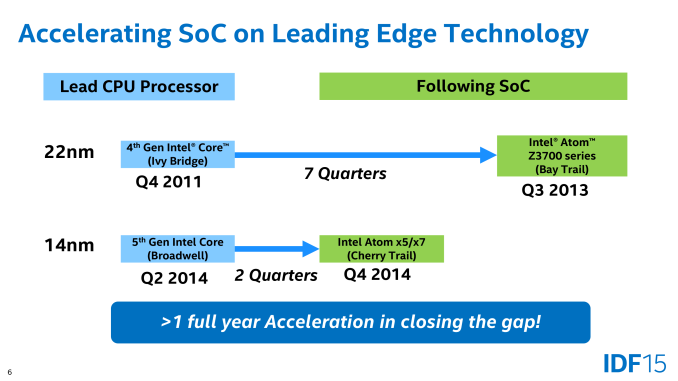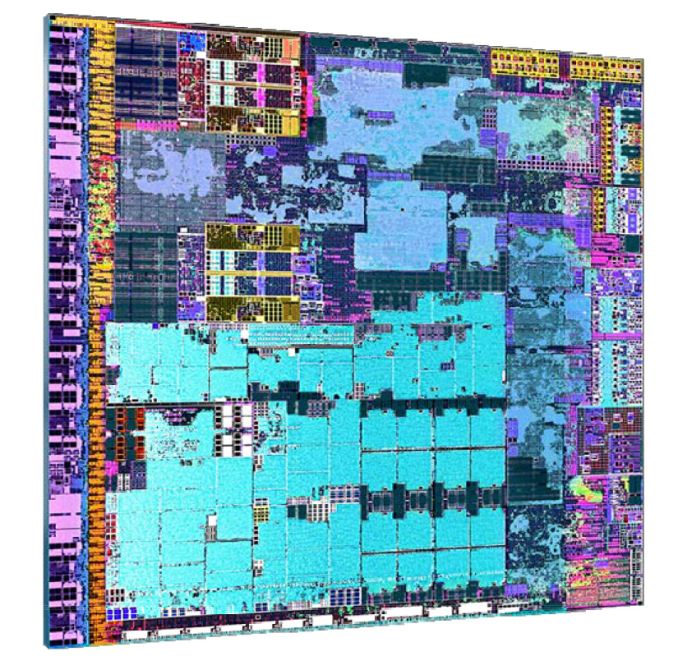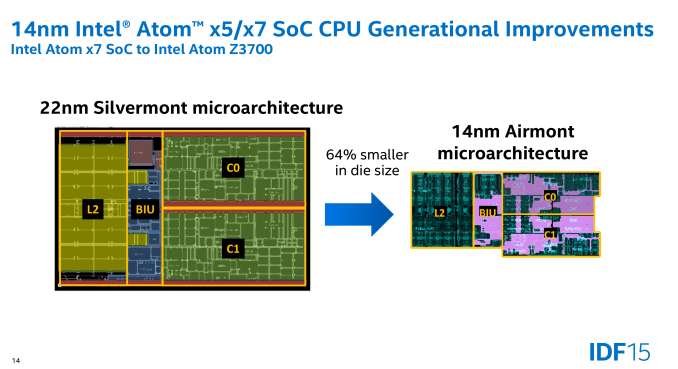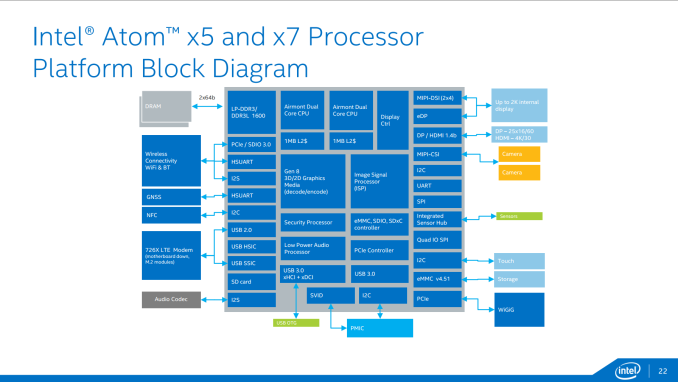The Surface 3 Review
by Brett Howse on May 4, 2015 9:00 AM ESTPowering the Surface 3: Intel’s Atom x7 System on a Chip
I still remember when back in 2011 Intel announced that they were finally going to stop treating Atom as a second class citizen at the manufacturing level, and bring it in line with the company’s mainstream Core processors. After having drawn out the 45nm and 32nm Atoms for too long, and suffering in the marketplace versus ARM as a result – Intel realized that to combat the growing threat of ARM they would need to treat the mobile market more seriously, and they would need to commit their sizable manufacturing advantage to the field to do this.
Now even Intel can’t turn on a dime – processors design begins half a decade in advance these days – so what have seen is a gradual ramping up towards this point. Silvermont, Intel’s first 22nm Atom, would introduce a more modern and better performing out-of-order architecture for Atom, meanwhile Intel would catch up on the manufacturing side by not producing 2 generations of Atoms on the 22nm node. Instead Silvermont would be the only 22nm Atom, and was to be followed by 14nm Airmont roughly a year later.
With Intel’s initial 14nm problems that year later ended up being a bit longer than a year, but in 2015 we’re finally there, and the change is remarkable. Only one generation ago, Intel launched their 22nm process as they always do, with desktop and high-performance laptop processors first. Now with 14nm the tables have been turned; Atom didn’t get first-dibs on 14nm – that went to Core M – but Airmont is still going to beat Intel’s desktop and high-performance Broadwell SKUs to the retail market. In one generation Intel has gone from favoring the desktop to favoring mobile, that’s how serious Intel has become.
That brings us to Surface 3, and the SoC powering it: Cherry Trail. The successor to the Silvermont-based Bay Trail that has powered so many x86 tablets in the last year, Cherry Trail is a distinct tick in Intel's tick-tock cadence. What this means is that Intel has largely retained the same architecture as in Bay Trail, investing in a fairly small number of updates, looking to take advantage of the power consumption and die size (cost) benefits of 14nm. To that end Intel has not even bothered to announce any major architectural changes for Airmont, and while there will likely be a few tweaks made to the CPU to make it work more efficiently on 14 nm, we will have to wait for Goldmont for the next big Atom architecture.
Cherry Trail itself is a fairly small chip. While Intel hasn’t released an official die size for it (no more than they did Bay Trail), from various IDF presentations they have released official numbers for the complete package, and decent photos as well. As a result we can take a decent stab at die sizes, and from Intel’s photos we’d estimate that the die size is around 83mm2. Unfortunately we don’t have anything quite comparable to Bay Trail, though we believe it to be a good bit smaller than Intel’s previous generation tablet SoC. At 83mm2 this would put the die size at quite a bit smaller than Apple’s A8X tablet SoC, and actually is just a hair smaller than the A8 phone SoC’s 89mm2.
Diving a bit deeper, Intel has also released some size data for individual Silvermont/Airmont CPU modules. The dual core modules, which contain the 2 CPU cores along with L2 cache and appropriate glue, have shrunk significantly from Silvermont to Airmont. Overall the Airmont CPU module is 64% smaller than the Silvermont module. And to be clear that does not mean Airmont is 64% of the size of Silvermont, that means that Airmont has been reduced by 64%; relative to Silvermont it is only 36% of the die size. Intel has achieved a better scaling factor than 22nm to 14nm alone, indicating that they have almost certainly enacted further optimizations to bring down the die size as an architectural level.
Moving on to the architecture of Cherry Trail, each Airmont core is a two-wide instruction decode with out of order execution. The L1 cache is 32 KB 8-way associative for instructions, and 24 KB 6-way associative data cache. Level 2 cache is 16-way associative with 1 MB of cache shared between two cores. There will be either two or four core versions available, which means that each SoC will have between 1 and 2 MB of L2 cache depending on the number of cores. There is no L3 cache on Atom.
The System on a Chip (SoC) has support for LP-DDR3 or DDR3L 1600 in dual-channel configuration, and has the blocks needed for PCIe 3.0, USB 2.0, USB 3.0, and support for up to three displays with eDP, DP, and HDMI 1.4b. The built in storage support is eMMC v4.5.1, which is typical for a tablet class processor.
Here is a Block Diagram of the SoC.
The one truely major change to the SoC is the inclusion of Intel's Gen 8 Graphics. Bay Trail used Gen 7 Graphics from Ivy Bridge, and Bay Trail only had 4 Execution Units (EUs) available. Cherry Trail ramps that up significantly, with the latest Gen 8 Graphics from Broadwell now onboard, bringing forward Intel's GPU enhancements over the last two half generations, not to mention the compute enhancements as well.
In terms of execution hardware the x7-8700 model has 16 EUs available, indicating that Intel has spent a significant amount of their die size savings from the 14nm process on graphics resources. Gen 8 has eight EUs per sub-slice but a minimum of three sub-slices in the design, and therefore in order to improve SoC yields the thread scheduler will dynamically allocate the right amount of cores per-subslice to total 16. For comparison, Intel's Broadwell line of Core processors have a minimum of 23 (but most have 24) EUs available, and a maximum of 48, so with Cherry Trail Intel has closed the top-to-top gap in execution resources between Core and Atom to just 3-1.
In Intel’s datasheets, the Atom GPU is labeled as Gen8-LP to designate that this is a low power model being used in a tablet. The base frequency for this GPU is 200 MHz, with a boost of 600 MHz.
In addition to the GPU update, the ISP and hardware decode capabilities get a bump as well. There is full hardware acceleration for decode of H.263, MPEG4, H.264, H.265 (HEVC), VP8, VP9, MVC, MPEG2, VC1, and JPEG, as well as hardware encode for H.264, H.263, VP8, MVC, and JPEG. This marks the first Intel product to ship with the company's full, fixed-function HEVC decoder, making Atom the company's most advanced media processor, at least for this short moment.
The overall SoC is 17mm x 17mm, and the Z-height is 0.937mm, so it is quite a bit smaller than Core M’s 30mm x 16.5mm x 1.05mm package. Intel is not listing a Thermal Design Power for the Atom chip, but is instead listing it as a Scenario Design Power of 2 watts. The CPU base frequency is 1.6 GHz with a turbo frequency of 2.4 GHz, and there is also support for a Low Frequency Mode of just 480 MHz for extra power savings when needed.
| Atom x7-8700 | Atom Z3785 | |
| Architecture | Cherry Trail (Airmont) | Bay Trail (Silvermont) |
| Cores / Threads | 4 / 4 | 4 / 4 |
| Base Frequency (MHz) | 1.6GHz | 1.5GHz |
| Turbo / Burst (MHz) | 2.4GHz | 2.4GHz |
| L2 Cache | 2 MB | 2 MB |
| SDP | 2 W | 2.2 W |
| GPU Architecture | Gen 8 | Gen 7 |
| GPU Execution Units | 16 | 4 |
| GPU Frequency / MHz | 200-600MHz | 313-833Mhz |
| DRAM | LPDDR3-1600 | LPDDR3-1333 |
So what we really have here is a massaged Bay Trail class chip, but the 14 nm process should allow for a higher period of sustained turbo frequencies to help out with performance. It will be interesting to see what Intel does with Goldmont, and if they will add things like hyper-threading or not, but that discussion is for another time.
















265 Comments
View All Comments
Alexvrb - Monday, May 4, 2015 - link
Actually in many regards the Surface 3 has the superior display. Sorry! Also in terms of SoC performance, the CPU side of the x7 is great and very competitive. If you're looking for 3D performance it's not as impressive but this would not be the best device for that workload - you'd be better off with a laptop/hybrid or a Surface Pro!Speedfriend - Tuesday, May 5, 2015 - link
"And people buy it because it doesn't run windows, too."Increasingly people don't buy the Ipad if the plummeting sales are any indication. My iPad stay on the sofa for basic web browsing, email and videos. Anything else I have to get my laptop for, becuase the iPad is basically pretty useless. And having recently bpought a cheap Android tablet to carry to work to watch movies on, I have realised that an iPad offers nothing that a cheap Android tablet can't do. I will never buy another iPad, it is just an overpriced toy. I wil buy a Surface though as it can actually replace my laptop for almost every task.
romprak - Tuesday, May 5, 2015 - link
The iPad is showing its lack of utility even in Apple's lineup, where large phones handily do most of the stuff an iPad used to be relied upon, and cheap tablets do web browsing as well as an iPad. Tablets are great for families, but why buy a $500 tablet for your child, when devices that can do almost as well are available for much, much less - and your children are unlikely to care too much whose logo is on the device?Apple is in trouble with the iPad, they need to either update the OS or come up with something killer for it.
In contrast, my family can use a Windows machine for all sorts of stuff - from programming (my 10 year old son is programming now), all the way to playing games on Steam. So, why iPad? Seems superfluous.
akdj - Tuesday, May 12, 2015 - link
I wouldn't call the 'slack' quarter sales of 17 million iPads 'trouble for Apple'. They sold more iPads then every Surface sold in aggregate, since its birth....last ¼ Alone! And that's six months post release.I like the SP3 Pro, I think MS nailed it. Surface 3 looks like a very nice step forward. That said, Apple HAS updated the OS and as an ambidextrous user or both Windows and OS X, I've found the continuity/handoff features built into iOS 8/OS X 10.10 to easily be the biggest advancement in some time --- especially between devices; phone, tablet and desktop or notebook.
Funny thing, I've got a ten year old as well. Also coding right now --- and I'm learning with him. He's building a cross platform app for his science fair.
He's coding on iOS only. Although he's got access to the iMac and MacBook Air, he's much happier learning both Objective C/Swift on iOS, using the free university lectures, notes and information along with a couple very excellent 'touch' coding 'apps'
It's funny to listen to rehashed arguments about the iPad and how it's for the couch potato only. I've flown 22 hours since Saturday morning, around Alaska with tourists looking to fish, shoot stills or motion, capture audio or wrap production in other areas of the state. My iPad is my kneeboard; plans my flights and files my plans, distributes weight and balance of the A/C, shows me real time weather, traffic, and up to date Jep charts and plates. It's been invaluable as a 'display' for small field edits, using as a remote viewfinder to capture sketchy wildlife and there's never a concern with battery life.
I do enjoy reading on the iPad, creating, invoicing clients or paying my utilities. I can take calls, use MS Office (whoever said it's a stripped version obviously hasn't used iOS Office, it's amazing!) Dropbox or iCloud, Box or Google Drive (I've found many Google apps to be better on iOS than my Android devices, currently using a Note 4), as well a plethora of powerful apps like iMovie, GarageBand, Pages Numbers and Keynote...all optional, none are bloated. iOS takes up a ½ dozen GBs, not two dozen! And if the RT3 suffers this much graphically, there's a LIMIT on 'all those X86' programs that actually WILL run on the rig
Sure, you'll be able to run CS3 efficiently and it sounds like games from a decade ago might work, but Iike the iPad, you're not gonna be manipulating 50megapixel Raw images nor creating killed effects in AE or transcoding video any faster. There's a trade off either way and IMHO, it's cool to see this significant a jump in performance on the new RT
I was also impressed with the SP3. That said, the iPad Air 2 is one helluva tablet at one pound and using TCAS and ADS-B with three dimensional moving maps with weather and traffic, GPS and nav aids that were easily 50-60 pounds for each pilot to carry around or avionics to add... Now in less than a one pound package, it's definitely NOT in trouble.
I think it's such an excellent device --- my original as well as iPad 2 are working great and the kids love them...most folks aren't updating them like phones. They're still selling nearly a 100,000,000 a year! That's hardly trouble. Even if the slip YoY spooks you, just remember how many are already out there, that the mini is only two and half --- 1 ½ with retina, and the Air 2 was the tick. Not that tock...yet they've managed to sell more in their worst quarter than every other tablet manufacturer combined! (Not to mention their mind blowing 6 & 6s sales, I'm sure their just fine canabalizing their own iPad sales with 6 and 6+ sales which are also pocket computers).
Times have changed and 'most' folks have everything they need in today's tablets. Today's smartphones. Regardless of which OEM they've decided on. Once they're happy, it's kind of a pain to 'change over' and these are extremely personal devices when compared to the home computer
Sorry about the length. But I enjoy and love using both OS X and (one of about six or seven dolts that enjoy using) Win 8.1. I've also used Android since 08 (still have my Xoom!) and iOS since '07. I currently use a Note 4 and 6+. Biz. Personal. As much as I enjoy Windows, OS X is certainly the 'go to OS' in our house.
Not to mention, OS X comes complete with training wheels for someone like romprak. It's called Bootcamp and you're welcome to install any OS you'd like. Unlike Windows.
bobjones32 - Monday, May 4, 2015 - link
For your claim of better performance, how well does the iPad run Win32 apps?mkozakewich - Tuesday, May 5, 2015 - link
That's not performance, that's functionality. If the exact same chip magically supported dual-booting x86 Win10, I'm sure it would do slightly better. That's not the power of Atom, though. It wasn't designed to blow everything else out of the water. (I'm sure it'll get better power characteristics on heavy load tests, for instance, because of its conservative power use.)What it all boils down to: This is a great device. It's different than an iPad, though, and different people will need different things from it. I feel a premium tablet can live at $500-$600, but a slightly-compromised tablet that runs Windows and is only truly complete with a $120 accessory will need to sweeten the deal to have obvious value to the common consumer.
It's a close game, but Surface needs a nudge. I suppose it'll get that in a couple months when it goes on sale for a bit.
MrTetts - Tuesday, May 5, 2015 - link
I never understand people who say this device is overpriced.. I just don't. For what it does, I would say it is very well priced.Stevegt87 - Thursday, May 7, 2015 - link
While the surface 3 is more capable than an ipad. A new ipad runs 100% of ipad software perfectly. Surface 3 is low on cpu/gpu/ram/disk for much of the desktop experience that it enables.Stevegt87 - Thursday, May 7, 2015 - link
Game are made to run perfectly on an ipad. Games will humble surface3augiem - Monday, May 4, 2015 - link
This thing is already $100 cheaper than a 128GB Air 2, does WAY more, has more memory, etc. How cheap is cheap enough? Would you really want them to sacrifice something like build quality, screen quality, or other necessities to reach a price point lower than this? They do have to stay in business after all. Running full Windows in the tablet space is completely unheard of and adds far more than $50 worth of value to this product compared to its competition.